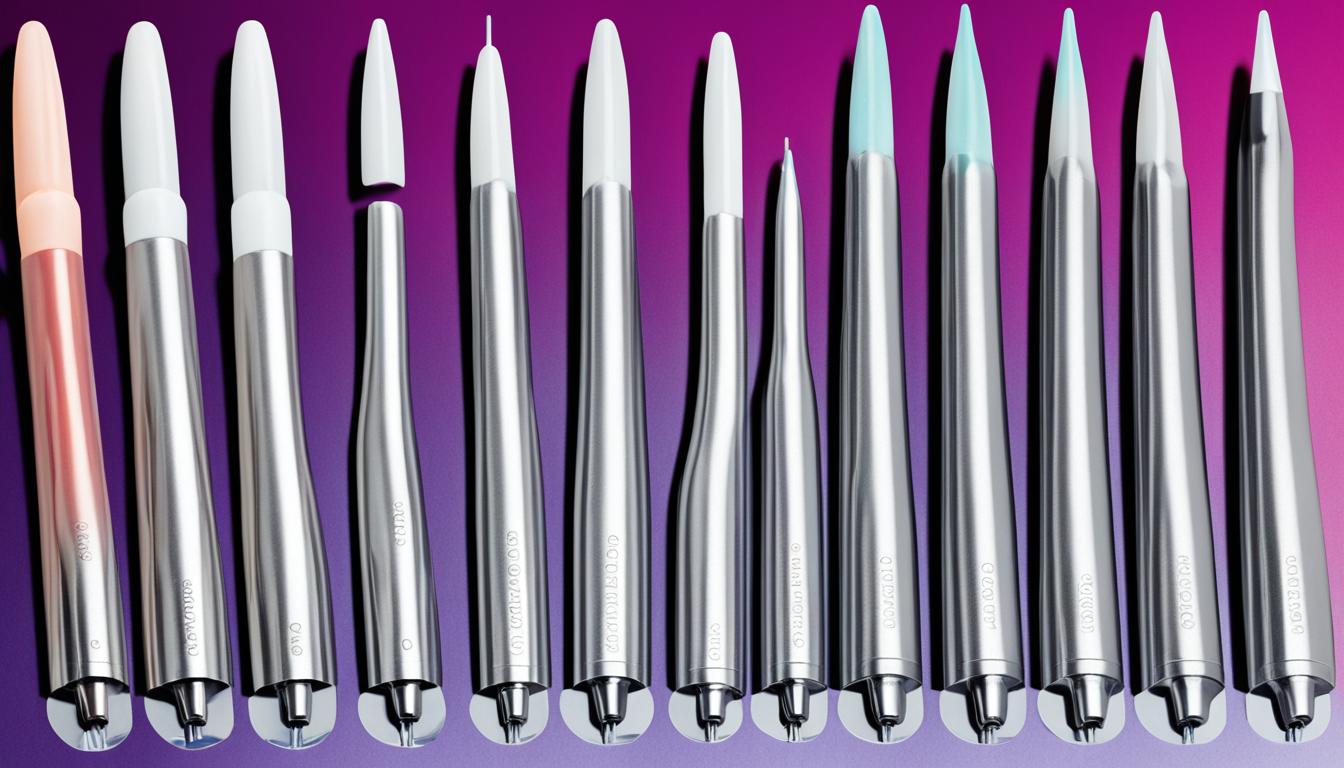A cannula is a thin tube used in medical work for many reasons. For example, draining fluid or giving medicine, or adding oxygen. IV cannulas go into a vein. Nasal cannulas pump oxygen through your nose with soft tubing.
But, how do cannulas really work? How do they get put in? And, what issues might come up? Let’s find out more about cannulas and answer these questions.
Key Takeaways:
- There are two main types of cannulas: IV cannulas and nasal cannulas.
- IV cannulas are put in veins for things like blood transfusions, giving medicine, and fluids.
- Nasal cannulas pump oxygen to help with breathing problems and low oxygen levels.
- IV cannulas have various sizes, shown by gauge numbers from 14 to 22. Bigger numbers mean smaller cannulas.
- IV cannulas differ in flow rates by size. For instance, a 14 gauge passes 270ml of saline in 1 minute. In comparison, a 22 gauge lets through 31ml in 21 minutes.
- Nasal cannulas adjust in oxygen flow too. Regular ones offer 4-6 liters per minute. High-flow systems can give up to 60 liters per minute.
- Using IV cannulas may cause problems like pain, blood clots, infections, bleeding, and bruises. Nasal cannulas could lead to rainout aspiration or throat swelling if not used right.
Types of IV Cannulas
IV cannulas come in several types for different medical needs. It is important for both doctors and patients to know about these types. The main ones are peripheral IV cannulas, central line IV cannulas, and draining cannulas.
Peripheral IV Cannula
Peripheral IV cannulas are the most used. They are common in places like emergency rooms. They are for short-term needs and put into veins in the arm. This is to give fluids, blood, medicine, or dye for tests. These cannulas have colors that show their size and use. This helps doctors pick the right one quickly.
Central Line IV Cannula
Central line IV cannulas stay in the vein for weeks or months. They go into bigger veins in the neck, chest, or leg. This allows medication to be given quickly into the main blood flow. They are used in serious care and for complex treatments or feeding.
Draining Cannula
Draining cannulas help remove fluids during surgery. They are used in procedures like liposuction or when draining an abscess. These cannulas pair with a trocar to safely remove fluid.
Each IV cannula type has a specific job. Peripheral ones are for short needs, centrals are for ongoing care, and draining ones remove fluids. Knowing this helps doctors choose the best care for their patients.
Sizes and Flow Rates of Cannulas
Cannulas come in different sizes for various medical needs. The main sizes for IV cannulas are from 14 to 22 gauge. Smaller numbers mean the cannulas are larger. This variety helps choose the right size for each patient’s need.
The flow rates of cannulas change with their size and type. A 14 gauge IV cannula allows more flow than a 22 gauge. For example, a 14 gauge moves 270 ml of saline in 1 minute. A 22 gauge moves 31 ml in the same time.
For patients needing extra oxygen, nasal cannulas are used. The usual flow for these is 4–6 liters per minute. But, high-flow systems can give oxygen at 60 liters per minute.
Healthcare providers pick the right cannula size and type for each patient. They match this to ensure medicines, fluids, or oxygen are given perfectly.
Insertion Techniques for IV Cannulas
Inserting an IV cannula is a detailed process. A healthcare pro will have you sit or lay down. Your arm, usually the non-dominant one, is stretched out for this. This helps spot the best place to insert the IV, where veins are easy to see.
They kick things off by cleaning the spot with an alcohol wipe. This helps keep infections away. Then, they tie a tourniquet above the place to cut down on blood flow. It also makes the veins pop out more.
The needle goes in next, aiming for a vein. It can be a bit uncomfortable but shouldn’t be really painful. The cannula slides into the vein over the needle. After placing the cannula correctly, they safely take the needle out. The cannula gets taped down to stay in place.
If you feel more than a little scratch or discomfort, let them know. They want to make sure you’re as comfortable as possible. A well-done insertion and keeping the cannula secure makes everything safer and more effective.
Insertion Techniques for Nasal Cannulas
Inserting a nasal cannula correctly is key for good oxygen therapy. It’s not hard and doctors or nurses can do it. These are the steps for putting it in:
- Prepare the equipment: First, make sure the flow meter is connected well and the oxygen flows right.
- Position the patient: Have the patient sit up straight in a comfy place. This makes the nostrils easy to get to and ensures a good fit.
- Insert the prongs: Put the prongs gently into each nostril. They should be comfy and not hurt.
- Loop the tubing: After that, place the tubing over the ears. This keeps it from moving around.
- Adjust the slider: Slide the plastic part under the chin to hold it in place. This makes sure it stays where it should.
- Check comfort and pressure: Keep checking if the patient is comfortable. The cannula should fit snug, but not too tight.
- Monitor the flow rate: Lastly, watch the oxygen level closely. Adjust it so it meets the patient’s needs.
These techniques work in hospitals and at home. At home, you can connect a portable cannula to oxygen for easy use. Always do as your healthcare provider says for using and caring for the equipment.
Getting the cannula in right and in the best spot is key. It helps with the oxygen and keeps the patient comfy. Health pros use these steps to make sure the cannula works well for patients.
Risks and Complications of Cannulas
Cannulas are often safe for medical use. But, they do come with some risks. Healthcare workers must know these risks. This will help them lower the chance of problems.
IV Cannula Risks and Complications
IV cannulas can have some issues. These may include:
- Pain at the insertion site
- Blood clot formation
- Infection
- Bleeding
- Bruising
- Phlebitis (inflammation of the vein)
These problems are not common. But, patients should be watched for them. Quick help and good care can lessen the risks of using IV cannulas.
Nasal Cannula Risks and Complications
Nasal cannulas with added moisture have their own risks. They include:
- Rainout aspiration: This happens when a person breathes in water. It comes from the condensation in the tube. To avoid this, proper moistening is vital.
- Airway inflammation: Cool and dry air from regular nasal cannulas can irritate the airways. This is hard for those with breathing problems. But, nasal cannulas with warm moist air lessen this issue.
It’s key for healthcare teams to check on each patient’s needs with nasal cannulas. They can make changes to keep patients comfortable and avoid problems.
“It is crucial for healthcare professionals to prioritize patient safety and closely monitor the use of cannulas to mitigate potential risks and complications.” – Dr. Sarah Thompson, Chief Medical Officer
Cannulas vs. Catheters
The terms “cannula” and “catheter” get mixed up a lot in medical talk, but they’re not the same thing. They each have their own job.
A cannula is a small, flexible tube that goes into the body. Used with a needle to help, they access veins or cavities. Doctors use them in IV therapy to give medications or fluids straight into the bloodstream. They’re also used to put oxygen into a patient’s lungs and help with anesthesia during surgery.
On the flip side, a catheter is bigger and meant for places that are already open, like the bladder. They’re used for draining urine or in heart procedures like angioplasty. In serious medical situations, central venous catheters help give medications or nutrients straight into big veins.
Both help with the same things, like giving medications or taking fluids out. But, they differ in size and where they’re used. Cannulas are smaller and for short-time use, while catheters are bigger and might be used for longer. Cannulas are also bendy, making them easy to put in and move, unlike catheters, which are designed to fit precisely in the body.
Denex International has a wide selection of IV cannulas and catheters to suit doctors’ needs.
These facts show how IV and nasal cannulas come in different sizes and speeds, with their own set of risks. Health workers must know when to use cannulas or catheters. They need to pick the right one for each patient and procedure.
Indications and Contraindications for IV Cannulation
IV cannulation is common in medical procedures. It’s essential for taking blood samples and giving fluids, meds, and nutrition. Doctors choose veins with high internal pressure for IVs because they’re easier to find.
The upper arm’s outer veins are often picked for IVs. This is because there’s less risk of vein inflammation. It also doesn’t stop the patient from moving around. Plus, the upper arm is comfortable and has fewer risks of problems like dislodging or blood clots.
There are some things to watch out for with IVs. People with hurt, infected, or burnt arms need special care. Some IV fluids can hurt tissue if they leak out. These fluids are better for central veins if possible.
Sometimes, in emergencies, strong medicines can be given through an arm IV. This quickens treatment until a safer IV spot is found.
Some patients, like kids or those who are very overweight, can be hard to find a good vein in. But, we can usually find a way to give them an IV. Yet, there are things that make it risky, like blood that doesn’t clot well, or bad skin at the IV spot.
Healthcare folks should weigh the good and bad of IVs carefully. They need to think about the patient’s needs and risks. This way, patients can get the meds and fluids they need, safely.
Over a billion arm IVs are used worldwide every year. Nearly all hospital patients may need one. It’s key to place IVs correctly and follow safety rules. This helps avoid problems and helps patients heal better.
Importance of Peripheral IV Line Placement and Care
Placing a peripheral IV line is key in medical care. Every year, over 1 billion of these lines are used around the world. They make it easy to give patients fluids and medicines straight into their veins. In fact, 80% of hospital patients will need one at some point. This shows just how important it is to put in and look after IV lines well.
A team effort is crucial to keep IV lines trouble-free. Nurses skilled in IVs team up with Managers or Clinical Nurses to ensure lines are put in right. They follow the best methods, lowering the chance of problems.
Doctors and nurses must always check the IV line closely. They look for issues like phlebitis, which shows the vein might be damaged. Early spotting of problems, like swelling or pain around the line, helps stop them from getting worse. Especially with kids getting IVs, hourly checks are a must to make sure everything is okay.
It’s vital for families and patients to understand IV care too. They should know when to call for help. Giving IV fluids also needs careful planning. It takes into account the patient’s health and the medicine or fluid’s safety. Before using the line, it must be flushed with clean saline to keep it open and safe.




